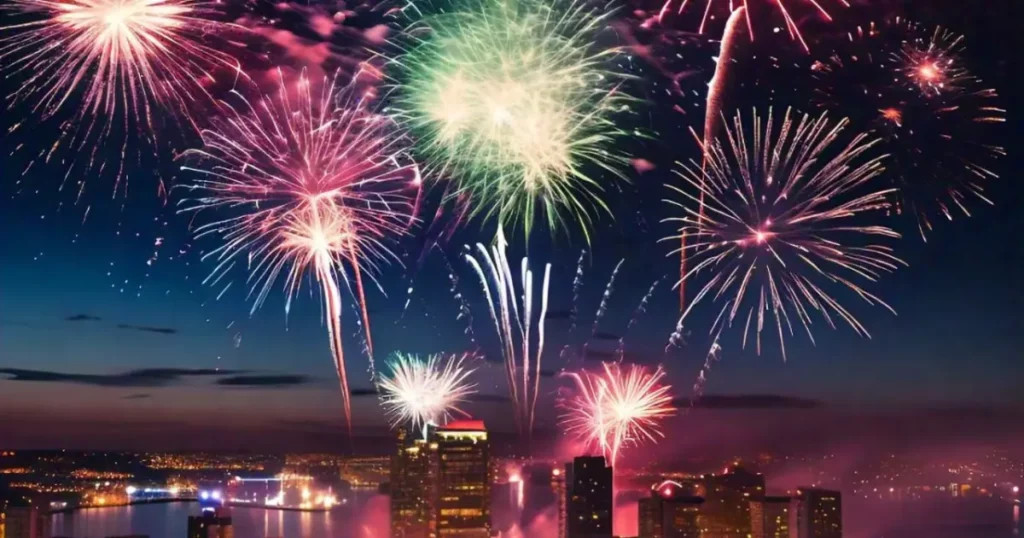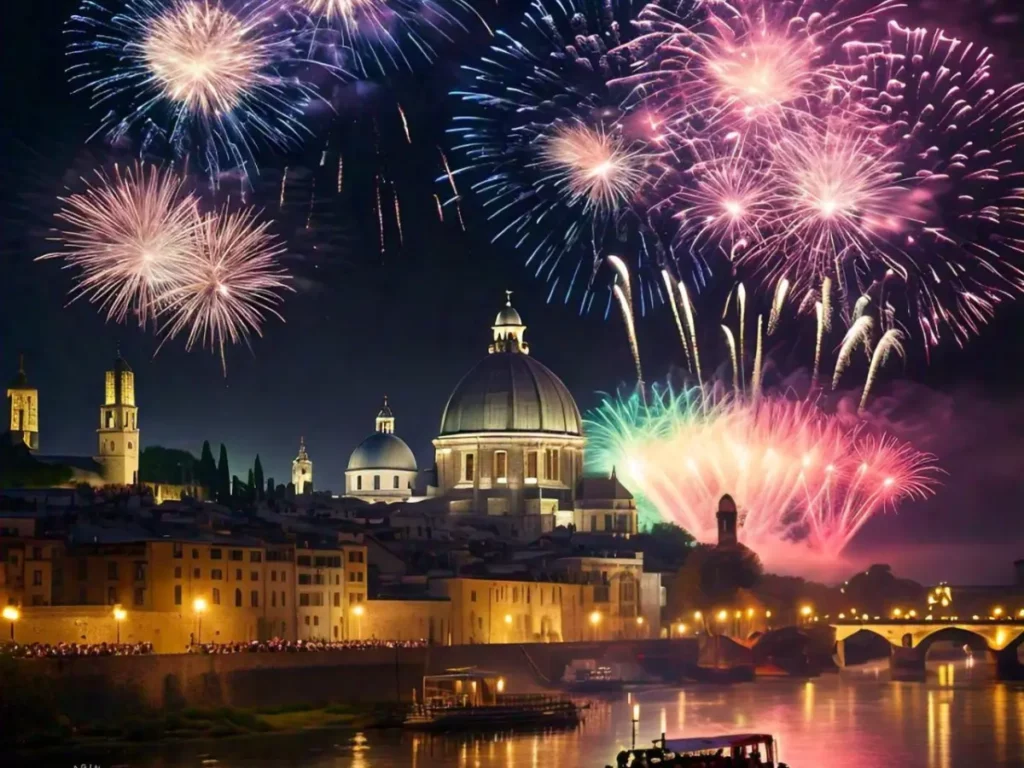
Introduction to Fireworks in Early America
Fireworks have been a vital part of American culture since the dawn of time. Prior to their arrival in the new world, early settlers’ fascination began in ancient China and extended to Europe. In 1608, the English settlers at Jamestown, Virginia, set off the first fireworks in American history to herald their arrival. As the territory expanded, fireworks became more common, appearing at festivals and carnivals.
Not only did fireworks symbolize joy and festivities, but they also symbolized patriotism. Significant occasions, like the first Independence Day celebration in 1777, necessitated the use of fireworks to commemorate the nation’s founding. With time, this tradition evolved.
Colonial Beginnings: Fireworks in Early American Celebrations
The firework in America quickly became a component of the communal festivities that Americans cherished. At Jamestown, Virginia, in 1608, English immigrants showed their love for fireworks, an awe-inspiring form of the firecracker.
They used fireworks as a way of celebrating and calling others together. It was considered the inaugural pyrotechnic display in the New World. As the settlers became more numerous, it became customary for them to ignite explosives whenever they gathered and socialized. It eventually became customary for friends to come together and have fireworks.
Fireworks in America: a Part of Significant Occasions
Parties, congregational hubbubs, and other significant occasions typically utilize the explosion as a classical representation of joy. During the 18th century, people used firework explosions to celebrate significant anniversaries and events like the Declaration of Independence. They started their journey as colonists. Firework exhibitions were not unique but they were entertaining. If sporadic, they allowed the fires to operate in the environs of fellowship.
Moreover, they established a formula for future customs on American soil. By symbolizing celebration while simultaneously mourning the loss of liberty and pride in neighboring nations. Its use in various American gatherings is a reflection of changing American values and priorities.
Lighting Up the Revolution: Fireworks in the Fight for Independence
During the American Revolutionary War, fireworks became synonymous with celebration and freedom. Though, it serves as a symbol of joy as colonies under French dominance fought for their independence from British colonization. Fireworks in America became a way to celebrate, show patriotism, and get excited while the stress of the war for independence grew. Even before the war’s formal victory, fireworks symbolized hope and defiance.
Excerpt People celebrated July 4, 177, the first anniversary of the Articles of Independence with great enthusiasm. Individuals often envision it as a grand fireworks extravaganza today. Despite being amid a war, the Americans decided to celebrate their new country by lighting up fireworks. All future Independence Day celebrations will follow this example.
Furthermore, the revolutionary cause mobilized citizens by deploying fireworks. Political and military leaders employed pyrotechnic displays to assemble crowds and pass on messages of solidarity or resilience. The use of fireworks dates back to the Revolutionary War. Which is really embedding them within what it is that we associate with national pride and American patriotism.
The first Independence Day fireworks marked the birth of a nation
The first use of fireworks occurred on the earliest Independence Day in 1777. It marks a significant turning point in American history. Less than a year after the Declaration of Independence was signed, America celebrated its independence by exploding objects! This sparked the tradition of lighting fireworks to celebrate Independence Day.
Americans came together on July 4 in celebration of the one-year anniversary of Thanks! Parades, speeches, and splendid fireworks lit up the night sky during this celebration.
This was a cause for celebration and an expression of hope, unity, and patriotism in the most powerful manner. Fireworks helped the new nation’s inhabitants feel part of something bigger than themselves and more connected. Firecrackers united a people proud of their own country.
This first-ever event pioneered the idea of fireworks in America on Independence Day celebrations. Fireworks are now an annual expectation, as they have diffused from Fourth of July celebrations in communities in USA. Therefore, the bright flashes and colors act as a constant reminder of the hardships, victories, and highest ideals of independence.
Patriotic Displays: Fireworks in the 19th Century

Throughout the 1800s, fireworks in America continued to evolve as an icon of pride in one’s country and patriotism. Hence, she uses fireworks from its independence to public events, governmental functions, and national holidays, perpetuating American cultural heritage.
During the 1800s, fireworks became a prominent feature in commemorating significant historical events. Similar to the War of Triumph salutes or the Declaration of Independence anniversary celebrations. These exhibitions provided entertainment for crowds but also visually represented the cultural memories and identity of a nation.
Political leaders also used fireworks to rally political support and national unity among the citizens. Grand fireworks displays often punctuated the end of public addresses, always evoking themes of liberty and democracy: WE THE PEOPLE… AMERICAN EXCEPTIONALISM! As the century progressed, advancements in pyrotechnics enabled the firing of increasingly elaborated. Which displays multicolored fireworks, presenting vivid new colors and shapes.
On top of this, fireworks helped cement the image of America as a paragon of democracy and freedom. They were frequently the centerpiece of state and county fairs as well as athletic events. Further more, social gatherings that symbolizes the country’s advancement and affluence.
Political Sparkle: Fireworks in Early American Politics
In early politics, fireworks in America served not only as a festive display but also as a weapon of political propaganda. Political candidates and leaders frequently employ this style. They use firework displays to attract attention, amplify speeches, and visually emphasize their points.
Fireworks creates a joyful atmosphere at campaign meetings, their majesty and splendor, helps stir up supporters. Which also attracts undecided voters.
Along with election campaigns, state celebrations, inaugurals, and civic rituals are also major historical events in American history. Fireworks displays works to create influential visual expressions of municipal pride and collective identity.
From Handcrafted to High-Tech: The Evolution of Pyrotechnic Artistry
It contains the development of pyrotechnic artistry in America from the handcrafted techniques to the state-of-the-art, high-tech development. Inexperienced artists brought fireworks in America to life with simple compositions like paper, bamboo, and gunpowder.
Due to the vivid colors and unprecedented effects, they were able to recognize holidays and major moments in American history. Earlier developments in chemistry and manufacturing drove a revolution in the pyrotechnics business during the nineteenth and twentieth centuries.
The Industrial Revolution’s mechanization and mass manufacturing processes allowed for the creation of more pyrotechnics in larger quantities. Which ensures greater uniformity and reliability. During this century, the spectacular and dazzling displays became increasingly creative and sophisticated. It was also the time that professional pyrotechnic firms and qualified technicians started to make their presence known.
Fireworks in America evolved throughout the twentieth century as firework shows began to use electronic and then computer-controlled devices. The electronic firing system allowed for precise timing, synchronization, and choreography of pyrotechnics.
Hence, modern fireworks combine artistic ingenuity with scientific precision to create stunning spectacles. Which are entertaining yet inspiring. They certainly meet rigorous safety and environmental standards.
Fireworks in American Festivals: A Tradition of Illumination
Fireworks, offering sparkling displays that illuminate the dark night and draw visitors from across the country. Which has become an integral part of American celebrations. Starting as early as the colonial days, fireworks epitomize joy, patriotism, and community celebration.
They are quite rampant at major national events like Independence Day. When their vivid colors and thunderous booms ignite patriotism and a sense of unity.
After the Declaration of Independence, fireworks have become an annual part of American democracy and freedom celebrations. These displays not only serve as a distraction but also serve as a symbol of unity within the country.
Over time, advances in pyrotechnic technology have complemented the display. Which resulted in solutions for increasingly complex designs, coordinated performances, and special effects, pushing the boundaries of creative expression.
Modern Marvels: Fireworks in Contemporary American Culture
Fireworks today have evolved into ultra-modern marvels across America, continuing to thrill spectators with their display of technological strides. The pyrotechnic events have become a part of larger celebrations and special events in America. Which includes conjuring creativity, finesse, and a sense of community celebration.
Today’s fireworks display is an event that showcases wedding artistry using ground-breaking technology, music with movements, and stunning visual effects. In this regard, advanced electronic firing systems present the facility of exact timing and synchronization. Which improves the overall impact and immersive experience of the display upon viewers.
Moreover, fireworks continue to be a part of numerous national events, like the expression of Independence Day. Thus, it represents timeless values in freedom and nationalism. However, it is also used as a signal for festivities for different cultural festivals, sports events and other special occasions. Thereby, becoming a global symbol of celebration and unity.
Conclusion
The passion for pyrotechnics is not the only thing flowing into fireworks—that is, within American culture. Rather, a country such as the United States developed from the colonial era to modern-day explosive festivals. From their introduction by early colonists as celebration indicators to their symbolic relevance within American Revolution. Which represents patriotism and hope. Fireworks have organically become an integral part of American identity.
Basically, fireworks underwent changes throughout the nineteenth and twentieth centuries due to changing times and technological advancements. They continued to host massive and complex firework events, consistently serving as symbols of nationalism and celebration. They played a huge role in Independence Day celebrations, symbolizing lasting values such as liberty and solidarity.
Today, fireworks still inspire and bring Americans together at some of the more prominent celebrations and events. From lighting the night sky on the July 4th to display their splendor in cultural festivals and sports events. It is a rich tradition that reminds us of the resilience, range, and shared heritage of this nation.
Citations
- https://www.americanpyro.com/history-of-fireworks
- https://duncansfireworks.com/blogs/all-things-fireworks/history-of-fireworks-in-the-united-states
A must Read on Beyond Barbecue and Fireworks:Celebrations in July
-
Good, I like the way you write ✍🏻
-
Well it is very smartly researched and written,a good read of course, I have also written something in contrast.
-
I love how you covered both the technical aspects and the cultural significance of fireworks. It’s a perfect blend
Looking forward to your next article.



Leave a Reply